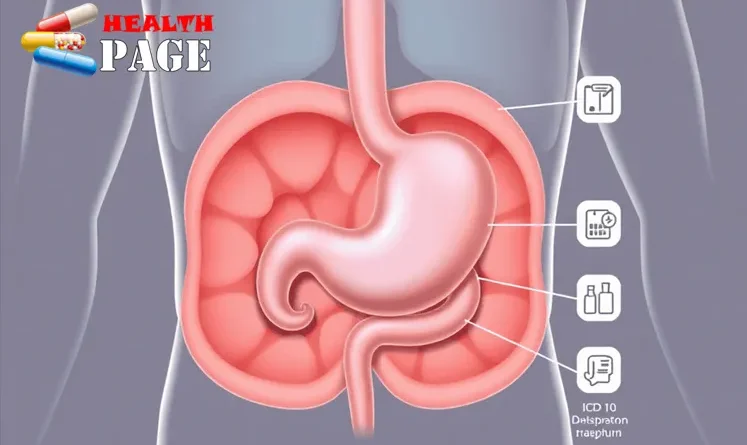10 Surprising Facts About Hiatal Hernia ICD 10 You Should Know
Did you know that a small muscular opening in your diaphragm could lead to serious health problems? A hiatal hernia happens when a portion of your stomach pushes through this opening – the hiatus – into your chest cavity. This common condition affects up to 60% of people by age 60, making accurate medical coding essential for proper treatment and documentation.
The ICD-10 coding system is the universal language for healthcare professionals to document and track hiatal hernia cases. These codes are not just random numbers – they are crucial tools that:
- Guide treatment decisions
- Ensure proper insurance reimbursement
- Enable accurate medical research
- Track disease patterns across populations
You might think medical coding is just administrative paperwork, but here’s the surprising truth: precise ICD-10 coding can mean the difference between a quick diagnosis and a delayed treatment plan. For hiatal hernia patients, this accuracy affects everything from insurance coverage to treatment options.
In this article, we will discuss 10 important facts about hiatal hernia ICD-10 codes that could change how you understand this condition’s documentation and management.
Understanding Hiatal Hernia in the ICD-10 System
The ICD-10 coding system, a crucial part of understanding medical codes and coding classification systems, provides specific codes to classify different types and complications of hiatal hernias. Here’s a detailed breakdown of the primary codes:
1. K44.9 – Diaphragmatic Hernia, Unspecified
- Represents standard hiatal hernias
- Includes sliding hiatal hernias without complications
- Most commonly used code for routine cases
2. Q40.1 – Congenital Hiatus Hernia
- Specifically for hernias present at birth
- Falls under congenital malformation categories
- Requires documentation of condition’s presence from birth
3. K44.0 – Diaphragmatic Hernia with Obstruction
- Used when stomach contents block the hernia
- Indicates presence of mechanical complications
- Excludes cases with gangrene development
4. K44.1 – Diaphragmatic Hernia with Gangrene
- Indicates severe tissue death
- Represents highest level of complication
- Requires immediate medical intervention
Each code carries distinct implications for treatment paths and insurance coverage. Medical professionals must document specific symptoms and diagnostic findings to support code selection. The coding system allows for precise tracking of:
- Disease progression
- Treatment effectiveness
- Population health trends
- Healthcare resource allocation
Accurate code selection impacts:
- Insurance reimbursement rates
- Treatment authorization
- Clinical research data
- Healthcare quality metrics
The ICD-10 system’s detailed classification enables healthcare providers to communicate precise diagnostic information across different medical facilities and insurance providers, underscoring the importance of understanding medical codes and their implications in the healthcare system as highlighted in this blog post.

Significance of ICD-10 Codes for Hiatal Hernia Diagnosis and Management
Precise ICD-10 coding for hiatal hernias serves as a critical foundation for both healthcare providers and patients. The impact of accurate coding extends far beyond simple classification:
For Healthcare Providers:
- Enables standardized communication between medical professionals
- Supports clinical decision-making processes
- Facilitates accurate medical record keeping
- Streamlines insurance claim submissions
- Reduces billing errors and claim denials
For Patients:
- Ensures appropriate insurance coverage
- Promotes consistent quality of care
- Creates detailed medical history documentation
- Supports accurate diagnosis tracking
The role of ICD-10 codes in epidemiological tracking proves invaluable for medical research and public health initiatives. These codes help identify:
- Prevalence patterns of hiatal hernias
- Geographic distribution of cases
- Associated risk factors
- Treatment effectiveness rates
- Population health trends
Moreover, the systematic approach of ICD-10 coding creates a universal language for healthcare providers, insurance companies, and medical researchers to communicate effectively about hiatal hernia cases. This is particularly important when it comes to maintaining patient privacy during the coding process, as explained in this HIPAA resource on de-identification.
Medical billing procedures rely heavily on precise ICD-10 coding. A single incorrect digit can result in claim denials, delayed payments, or inappropriate reimbursement rates. Healthcare facilities use these codes to:
- Generate accurate medical bills
- Process insurance claims efficiently
- Track healthcare costs
- Maintain compliance with regulatory requirements
- Document medical necessity for procedures
Types of Hiatal Hernias in the ICD-10 System
The ICD-10 system categorizes hiatal hernias into distinct types, each with specific coding requirements for accurate medical documentation. Understanding these classifications helps healthcare providers select the right diagnostic codes.
K44.9: Diaphragmatic Hernia, Unspecified
This code represents the most common type of hiatal hernia, including:
- Sliding hiatal hernias
- Esophageal hernias without complications
- Cases where the specific hernia type hasn’t been determined
The unspecified category applies when:
- Initial diagnosis is pending further evaluation
- Documentation doesn’t specify the exact hernia type
- Routine cases without notable complications
Key Clinical Characteristics
- Part of the stomach protrudes through the diaphragm
- Symptoms may include heartburn and acid reflux
- Can be asymptomatic in many cases
- May require lifestyle modifications or medical intervention
Documentation Requirements
- Physical examination findings
- Diagnostic imaging results
- Presence or absence of symptoms
- Related conditions affecting treatment decisions
Coding Tips
- Document any associated conditions
- Note specific anatomical details when available
- Include symptom severity
- Record treatment responses
The ICD-10 system allows for additional code combinations to capture the full clinical picture. Healthcare providers should document specific anatomical details, related symptoms, and any complications to support the selected code.
2. Congenital Hiatus Hernia (Q40.1)
Congenital hiatus hernia, coded as Q40.1 in the ICD-10 system, is a type of diaphragmatic hernia that is present at birth. It occurs during fetal development when the stomach and esophagus do not properly position themselves below the diaphragm.
Key characteristics of Q40.1 classification:
- Present from birth
- Associated with developmental abnormalities
- May occur alongside other congenital malformations
- Requires specific diagnostic criteria for accurate coding
The Q40.1 code falls under Chapter XVII of ICD-10, which is dedicated to congenital malformations, deformations, and chromosomal abnormalities. This placement distinguishes it from acquired hiatal hernias, emphasizing its unique developmental origin.
Clinical significance:
- Higher risk of complications in infants
- May require early surgical intervention
- Needs regular monitoring during growth
- Can impact feeding and respiratory function
Healthcare providers must document specific developmental aspects when using Q40.1, including anatomical details and associated congenital conditions for precise medical coding and appropriate treatment planning.
3. Diaphragmatic Hernia with Obstruction (K44.0)
The ICD-10 code K44.0 specifically identifies cases of diaphragmatic hernia where obstruction occurs without gangrene development. This critical distinction helps healthcare providers document and track complications accurately.
Key Clinical Indicators for K44.0:
- Presence of mechanical blockage
- Difficulty swallowing
- Severe chest pain
- Breathing complications
- Absence of tissue death
The obstruction in these cases can manifest through several symptoms:
- Persistent heartburn
- Regurgitation of food
- Sharp chest discomfort
- Difficulty breathing after meals
Medical professionals use K44.0 when documenting cases where the stomach or other abdominal organs become trapped in the chest cavity, creating a blockage. This specific code alerts healthcare providers to the severity of the condition and guides appropriate treatment protocols.
Documentation Requirements:
- Clear identification of obstruction
- Absence of gangrenous tissue
- Location and extent of herniation
- Associated symptoms
- Impact on patient’s digestive function
The obstruction can often lead to severe complications such as gastric outlet obstruction, which is characterized by a mechanical blockage preventing food from passing into the small intestine. Understanding these implications is crucial for effective management of the condition.
In addition to physical symptoms, the psychological impact on patients should not be overlooked. Research has shown that such medical conditions can lead to significant stress and anxiety, further complicating recovery and management.
4. Diaphragmatic Hernia with Gangrene (K44.1)
The ICD-10 code K44.1 represents a severe complication of hiatal hernias marked by tissue death. This critical condition requires immediate medical intervention due to its life-threatening nature.
Key characteristics of gangrenous hiatal hernias include:
- Severe pain in the chest or upper abdomen
- Dark or bloody vomit
- Rapid heart rate
- Fever and chills
- Significant tissue necrosis
Healthcare providers use K44.1 to document cases where:
- Blood supply to the herniated portion becomes compromised
- Tissue death has been confirmed through diagnostic imaging
- Emergency surgical intervention is necessary
The presence of gangrene changes the treatment approach dramatically. While non-gangrenous hernias might be managed conservatively, K44.1 cases require urgent surgical repair to remove dead tissue and prevent sepsis.
Documentation requirements for K44.1 include:
- Detailed imaging results
- Surgical findings
- Tissue death confirmation
- Associated complications
- Treatment procedures performed
This specific code helps track severe cases and supports research into prevention strategies for this dangerous complication.
Clinical Management and Reporting of Hiatal Hernias Using ICD-10 Codes
ICD-10 codes are essential tools in managing hiatal hernia patients. They provide a standardized system that directly impacts treatment decisions and patient care procedures.
Key Clinical Management Components:
1. Treatment Planning
The specific ICD-10 code assigned helps determine appropriate treatment pathways:
- K44.9 cases often receive conservative management
- K44.0 cases require immediate intervention for obstruction
- K44.1 cases need emergency surgical treatment
2. Documentation Requirements
Accurate documentation is crucial for effective management. The following details must be recorded:
- Detailed symptom descriptions
- Physical examination findings
- Diagnostic test results
- Treatment responses
Reporting Benefits:
ICD-10 codes also offer several advantages in reporting:
- Real-time tracking of patient progress
- Accurate communication between healthcare providers
- Streamlined insurance authorization processes
- Enhanced quality metrics monitoring
The ICD-10 coding system enables healthcare providers to implement evidence-based treatment protocols specific to each hernia type. This systematic approach supports:
- Medication management
- Surgical intervention timing
- Post-operative care planning
- Follow-up scheduling
Healthcare facilities use these codes to develop standardized care pathways, ensuring consistent treatment delivery across different departments and practitioners. The codes also facilitate quality assessment and outcomes tracking, leading to improved patient care standards.
Differentiating Between Congenital and Acquired Hiatal Hernias in the ICD-10 System
The ICD-10 system employs distinct coding practices for congenital and acquired hiatal hernias, reflecting their different origins and clinical implications.
Congenital Hiatal Hernias (Q40.1)
- Present at birth
- Part of developmental abnormalities
- Linked to genetic factors
- Often discovered during pediatric screenings
- May require early intervention
Acquired Hiatal Hernias (K44.9)
- Develop later in life
- Associated with:
- Age-related muscle weakness
- Pregnancy
- Obesity
- Trauma
- Classified based on severity and complications
The coding distinction helps healthcare providers:
- Track patient history accurately
- Plan appropriate treatment strategies
- Determine insurance coverage
- Monitor long-term outcomes
Proper code selection between Q40.1 and K44.9 impacts:
- Treatment protocols
- Surgical planning
- Risk assessment
- Documentation requirements
- Reimbursement rates
Understanding these differences enables healthcare providers to maintain precise medical records and select appropriate treatment pathways. The specific coding requirements for each type reflect their unique characteristics and management needs, ensuring optimal patient care and accurate healthcare data collection.
Conclusion
Accurate ICD-10 coding for hiatal hernias is crucial for effective healthcare delivery. Choosing the right code affects:
- Insurance claims processing
- Treatment planning
- Patient care coordination
- Healthcare cost management
- Clinical research accuracy
Healthcare professionals must understand that precise coding directly impacts patient outcomes. Misclassifying a hiatal hernia can result in delayed treatments, denied insurance claims, and compromised care quality.
Key Actions for Healthcare Providers:
- Stay updated with ICD-10 coding changes through regular training
- Document patient conditions thoroughly
- Keep detailed records of symptoms and complications
- Consult coding specialists for complex cases
- Review coding practices periodically
The best guide on hiatal hernia ICD-10 coding is one that evolves with medical knowledge and coding standards. Healthcare providers should bookmark trusted resources and participate in professional development opportunities focused on medical coding excellence.
Your commitment to precise coding practices ensures patients receive appropriate treatment options and insurance coverage. Make it a priority to review your facility’s coding protocols and implement systematic checks to maintain the highest standards of diagnostic accuracy.
[Need help with hiatal hernia ICD-10 coding? Connect with our coding specialists today.]
FAQs (Frequently Asked Questions)
What is a hiatal hernia and why is accurate ICD-10 coding important for it?
A hiatal hernia occurs when part of the stomach pushes through the diaphragm into the chest cavity. Accurate ICD-10 coding for hiatal hernias is crucial as it ensures precise medical documentation, facilitates correct billing procedures, and supports effective epidemiological tracking, ultimately enhancing patient care.
Which ICD-10 codes are used to classify different types of hiatal hernias?
The ICD-10 coding system includes several codes for hiatal hernias: K44.9 for diaphragmatic hernia, unspecified; Q40.1 for congenital hiatus hernia; K44.0 for diaphragmatic hernia with obstruction without gangrene; and K44.1 for diaphragmatic hernia with gangrene. These codes help differentiate between various types and complications of hiatal hernias.
How do ICD-10 codes impact the clinical management of hiatal hernia patients?
ICD-10 codes guide healthcare providers in selecting appropriate clinical management strategies by accurately identifying the type and severity of the hiatal hernia. This precision facilitates tailored treatment plans and improves overall patient outcomes.
What is the difference between congenital and acquired hiatal hernias in terms of ICD-10 coding?
Congenital hiatal hernias, present from birth, are coded under Q40.1 in the ICD-10 system, classified as congenital malformations. Acquired hiatal hernias, which develop later in life, are coded under categories like K44.0 or K44.1 depending on complications such as obstruction or gangrene.
Why is precise ICD-10 coding essential for insurance claims related to hiatal hernias?
Precise ICD-10 coding ensures that insurance claims accurately reflect the patient’s diagnosis and treatment needs, facilitating smooth claims processing and reimbursement. Incorrect coding can lead to claim denials or delays, affecting both healthcare providers and patients.
How can healthcare professionals stay updated with the latest ICD-10 coding guidelines for hiatal hernias?
Healthcare professionals should regularly consult official coding manuals, participate in continuing education programs, and utilize reputable medical coding resources to stay informed about updates in ICD-10 guidelines. Staying current enhances accurate documentation and optimal care delivery for patients with hiatal hernias.



Pingback: Acute Vestibular Syndrome (AVS): Symptoms, Diagnosis,
Pingback: Buckwheat Diet and Pancreatitis: Pros & Cons for Gut Health